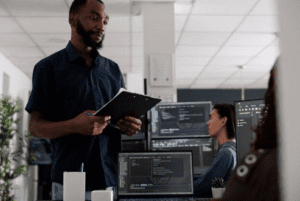Breaking New Ground In CMMC Assessments With Emerging Tools And Techniques
Cybersecurity Maturity Model Certification, or CMMC, audits are rapidly transforming as companies strive to meet the requirements set by the United States Department of Defense (DoD). This has been because the government has recently faced more than 80 cyber attacks, 44 of which were from other countries’ cyber operations. This necessitates the need for proper security mechanisms immediately.
As the nature of cyber threats continues to change, defense industrial base (DIB) companies must adopt new methodologies and technologies to make the process more efficient, improve security positions, and ensure compliance.
In such instances, traditional approaches are insufficient in order to address these new threats. As a result, new solutions are reshaping how organizations prepare for and navigate CMMC audits.
Read on to explore the latest innovations in tools and techniques that are transforming CMMC assessments.
Understanding the Role of Automation in CMMC Assessments

Automation simplifies CMMC assessments greatly.
In the past, assessments involved a lot of human interaction, whether through document reviews or the implementation of security controls. However, with automated software, all those are automated, with less human error and more efficiency in the process.
Main Functions of CMMC Assessment Automation
- Automated CMMC Audits: Efficient Compliance Procedures: Automated installations of the controls and reviews of documentation eliminate the need for human validation, making the process more efficient and less prone to errors.
- Total Vigilance for Compliance: Automated solutions place the security posture of an organization in a position that remains constantly compliant and minimizes the threat that random scans pose. This keeps organizations current with the evolving CMMC framework requirements.
- Proactive Threat Detection: Automated systems detect misconfigurations, vulnerabilities, and non-compliant systems even prior to when they pose significant security threats.
- Record-Keeping and Reporting: Automaton enables organizations to maintain proper records, generate compliance reports, and consistently apply security controls to all systems.
Emerging Tools Transforming CMMC Assessments
Below are some emerging tools transforming CMMC assessments:
1. Automation and AI-Driven Assessment Tools
Machine learning and artificial intelligence are changing how organizations deal with CMMC compliance. AI software browses through vast quantities of information to find patterns, identify suspicious activity, and predict potential cyber-attacks. This enables businesses to be proactive about security instead of reacting when the issues occur.
Risk software based on AI detects vulnerabilities even before their exploitation. Automated reports and documentation make the process easier, and organizations can choose to maintain their records current on compliance.
Predictive analytics forecast probable threats, allowing businesses to enhance security ahead of time. AI-based audits reduce the number of manual verifications, making the process more efficient and less prone to human error.

2. Cloud-Based Compliance Platforms
Cloud solutions offer a dynamic and scalable solution for CMMC compliance. Unlike on-site systems, cloud platforms allow organizations to monitor and enact security controls in real-time.
A significant benefit of cloud-based compliance platforms is centralized data accessibility, which makes it easier for teams to work remotely.
Cloud platforms also make it possible to track and report in real-time, enabling organizations to remain up to date with their security position at all times.
In addition, security patches and updates are handled automatically, keeping the systems secure without human intervention. Cloud solutions also lower infrastructure costs, as businesses do not need costly on-site investments in equipment.
Organizations can efficiently manage their CMMC assessments using cloud platforms with strong security protocols.
3. Zero Trust Architecture and Security Enhancements
Zero Trust Architecture, or ZTA, is a security model that applies the “never trust, always verify” principle. In place of trusting that devices and users on a network are safe, Zero Trust constantly verifies identities and applies stringent access restrictions.
Zero Trust complements the CMMC standards with the implementation of multi-factor authentication to prevent unauthorized access and denial on the principle of least privilege, where the user only gets the necessary assets for their role.
4. Blockchain for Audit and Compliance
Blockchain technology can potentially be a game-changer for CMMC audits because it enables a secure, transparent method for managing compliance records. Being based on a decentralized ledger, the audit histories are resistant to tampering and immutable.
One of the primary benefits of using blockchain is audit trail security. Any change to the records on compliance gets registered as a timestamped transaction, and unauthorized changes are impossible.
This transparency ensures the accuracy and reliability of the records on compliance.
Data integrity is also enhanced with the utilization of blockchain by preventing human error or manipulation of the reports on compliance.
5. Continuous Monitoring and Threat Intelligence Integration
One of the most significant developments in CMMC audits has been the move away from infrequent security audits towards continuous monitoring.
Instead of annual or bi-annual audits, organizations can use real-time monitoring software to remain compliant dynamically. This shift results in a more stable security posture and less opportunity for unknown vulnerabilities.
The following presents an overview of the major points on continuous monitoring and threat intelligence integration:
- Traditional Audits Create Security Gaps: Traditional security audits are performed on a set, recurring schedule, typically on a yearly or bi-annual basis. This leaves a gap when the system is not being audited, and new threats might evolve and exploit security vulnerabilities during the gap.
- Real-Time Visibility Through Continuous Monitoring: Organizations are able to achieve real-time visibility of their cybersecurity position through the use of AI and machine learning, implementing continuous monitoring solutions that provide ongoing measurement of compliance at all points rather than as a point-in-time measurement.
- Threat Intelligence Facilitates Proactive Defense: Threat intelligence platforms collect information from different sources, such as security research and network activity, as well as monitoring the dark web. These platforms also analyze potential threats in the future and provide actionable data to help organizations improve their security controls.
Best Practices for Emerging Techniques
A structured methodology has to be adopted to integrate new technologies with CMMC audits successfully. Organizations need to, therefore, plan properly, train employees, and monitor their procedures frequently to make the implementation process seamless.
Some best practices that aid the implementation of these technologies include;
1. Conducting a Gap Analysis
Organizations must analyze their current compliance system to identify the gaps and where improvement must be made before implementing new technologies. Gap analysis helps determine which technologies would be the most useful to implement.
This helps ensure that new technology investments are targeted toward specific compliance requirements.

2. Adopting a Phased Implementation Approach
Next, new tools must be phased in, not all simultaneously, so the organization can pilot, refine, and fine-tune them before using them broadly.
For example, businesses might use pilot programs with AI-driven risk evaluation software to test their efficiency before combining them with more significant operations. This minimizes disruptions and ensures a smoother shift while aligning with the requirements of different CMMC levels.
3. Ensuring Seamless Integration with Existing Systems
New technology needs to be integrated with the cybersecurity and compliance infrastructure of an organization. Cloud-based platforms for compliance, Zero Trust security models, and automation software must be installed to integrate with current security architectures.
Effective integration enhances efficiency and removes data silos, creating one source for CMMC assessments.
4. Developing Clear Policies and Workflows
Having defined policies and procedures ensures compliance teams understand the proper usage of new tools. Organizations must document the guidelines on the way AI-based tools gather evidence, the way blockchain stores audit trails, and the way continuous monitoring will be employed for threat detection.
Thus, clearly defined procedures ensure that the new technologies are applied consistently in assessments.
5. Investing in Training and Upskilling
Compliance teams and auditors should be trained in implementing the new security technologies. Organizations, therefore, need to offer hands-on workshops, online courses, and certification programs that teach teams about AI analytics, blockchain auditing, and zero-trust security concepts.
Further, simulated testing with new technology allows teams to gain hands-on experience before implementing it in real-life compliance audits.
Encouraging Collaboration and Knowledge Sharing
New technologies evolve rapidly, and staying current with the latest developments is critical. Organizations need to create internal forums for sharing knowledge or becoming members of industry forums to bring cybersecurity professionals together to work as a team. Peers can educate assessors on best practices, problems, and solutions when applying new tools within the framework of a compliance audit.

Establishing Continuous Monitoring and Evaluation
New technologies do not need to be installed on a one-off basis. Companies must constantly analyze their efficiency, adjust configurations, and optimize usage to cope with evolving cyber threats and regulations.
Also, automated compliance platforms and AI-driven monitoring solutions must be constantly updated with real-world data.
Addressing Data Privacy and Security Concerns
While cloud software with compliance and blockchain ensures better security, organizations must ensure that the technologies are DoD-compliant with cybersecurity standards. Strong encryption, role-based access control, and following data protection laws are all necessary to safeguard confidential information during CMMC audits.
Embracing Innovation for CMMC Compliance and Cybersecurity Resilience
The new security landscape requires more advanced methodologies and technologies to meet the CMMC requirements. The latest cyber threats cannot be met with the existing assessment methods. Organizations must implement automation, AI, cloud platforms for compliance, Zero-Trust Architecture, and blockchain to make their CMMC assessments more efficient, accurate, and secure.
These new technologies make it easier to comply with regulations and make the entire field of cybersecurity more robust. Organizations that implement these technologies will be more prepared to deal with the complexity of CMMC certification, protect confidential data, and meet the rising expectations of the United States Department of Defense.
As cyber-attacks evolve, keeping up with the latest technologies will be the means to comply and protect vital information.

Recent Comments